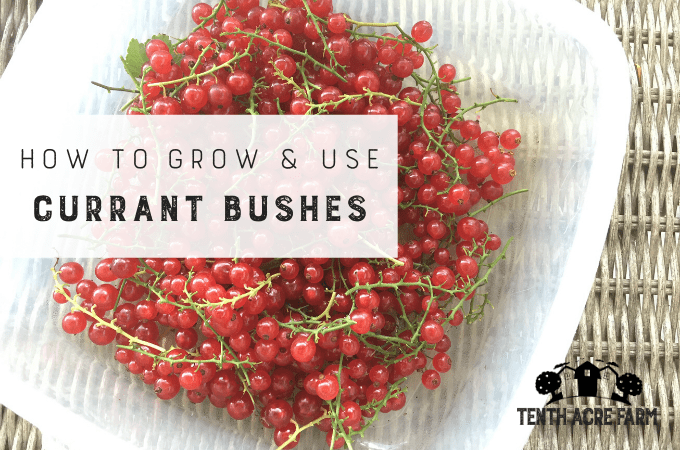Currant bushes are a great addition to the edible landscape. Here’s how I grow them in my landscape and use currants in the kitchen.

This page may contain affiliate links. Please read my disclosure for more info.
In this article:
- Using currant bushes in the edible landscape
- How to grow currant bushes in the edible landscape
- Choosing between black and red currant bushes for your edible landscape
- How much fruit does a currant bush produce?
- Harvesting currants
- Common pests and diseases of currant bushes
- Pruning currant bushes
- Using currants
- 7 FAQs about growing and using currant bushes
Currant bushes (Ribes) are thornless understory shrubs, growing in USDA hardiness zones 3-8. They can grow 3-6 feet wide and tall, and can range in color from red, white, pink, or black. There is even a clove currant (Ribes odoratum), which is very fragrant.
All currants have attractive flowers and maple-like leaves that make them desirable in the edible landscape. They can be planted in the understory of a permaculture food forest or hedgerow. They are one of many perennial crops that can tolerate moist areas.
Currant Bushes: Edible Landscaping for Shady Areas
There aren’t a lot of options for growing edible plants in the shade, so when I learned that currants can be full and productive in the shade, it was love at first sight. I replaced the traditional yew bushes lining our front porch with a row of currant bushes.
On the north side of the house, they’re almost completely shaded. I can’t believe how little they were at the time of planting!

I planted two each of ‘Red Lake’ red currants and ‘Consort’ black currants. You can find both varieties at Food Forest Nursery.
In hindsight, I should’ve chosen only one variety for a uniform look to the hedge. This is a basic landscape design principle called unity. Live and learn…
This berry bush grows naturally in dappled shade. There, it will produce more vibrant, darker foliage, which is good news for an edible landscape. On the other hand, they’re more productive in full sun.
With more sun, however, the shallow roots will require more watering during the hot summer and may be more susceptible to pests.

The mature currant bushes in the landscape
8 Ways to Grow Currant Bushes in the Landscape
Here are a few ways to grow the bushes:
- As a foundational hedge bordering the front porch. The spring flowers are gorgeous in the spring, and the berries dangle like bunches of grapes in early summer.
- In a shady, unused spot. Try planting them under oak, walnut, or apple trees, according to Gaia’s Garden.
- In a wildlife hedge. Birds love the berries. They are said to be deer-resistant, but I’m not so sure about that.
- In a poultry foraging area. Chickens like them, too.
- At the edges of open woods or in dappled shade in the woods (as in a food forest).
- In a pollination garden. The tiny flowers provide nectar for both hummingbirds and a menagerie of other insects.
- In your medicinal garden. Black currant leaves are known for curing quite a large array of symptoms and illnesses, from arthritis to colds and coughs. All currants are high in vitamin C and can be dried and eaten as a supplement during the winter months.
- In a jelly garden. While I think they’re a bit tart for fresh eating, they transform into a sweet and mellow taste when made into jelly.
Did you know you can also forage for wild currants? Learn how in this course I recommend.
Want to grow fruits, vegetables, and herbs in your front yard landscape without sacrificing curb appeal? Check out my mini guide, The Permaculture Inspired Edible Landscape.

Currant Bushes: Pretty in the Edible Landscape
Black currant bushes are more vigorous than red currants. They are fuller and more upright with straighter branches, and grow to 5-6 feet tall and wide. The leaves are bigger and the branches provide more interest in the winter because the red buds are bigger.
Alternatively, red currant bushes are smaller (3-5 feet tall and wide) and a little more scraggly-looking. But that’s kind of a neat look, too, with the gnarled branches. Clearly, it depends on what you’re looking for!

Yield of Currant Bushes
Annually, each of my red currant bushes produce about 2 pounds of berries, while my black currant bushes each produce about 4 pounds of berries.
My bushes are shade-grown, so grow in full sun to produce more berries.
Harvesting Currants
Harvest Season: Harvest the berries in the early summer. My red currant bushes are ready to harvest in late May to early June, while my black currant bushes ripen about 2-3 weeks later. They’re both harvestable for about a month.
How to Harvest: Harvest the whole bunch when all of the berries are ripe (like a bunch of grapes). Pick each berry from the stem before eating or processing.
Tired of generic permaculture design advice that you can’t apply to your specific goals? If so, check out my Permaculture Design Program and get the tools and support needed to create and implement your own permaculture design.
Pests and Diseases of Currant Bushes
They are susceptible to aphids and white pine rust, so don’t plant near white pines. Because of their ability to pass on the disease, they’re prohibited in some states.
The nursery can tell you if they’re prohibited altogether where you live, or if only certain varieties are prohibited. I haven’t experienced any pests or disease in my currant hedge.
Pruning Currant Bushes
Prune currant bushes in late winter when they’re dormant to achieve good berry production.
Cut back any stems that are touching the ground or that appear to be diseased or broken. Red currants produce most heavily on 2- to 3-year old stems, while black currants bear more heavily on 1-year-old stems.
Older, less-productive stems should be removed as the plants get older. Too many stems cause overcrowding and reduce productivity, so only keep 10-12 of the most vigorous, younger stems (1-, 2-, and 3-year old stems). Prune the rest back.
At this time, you can also shape currant bushes into a tidy hedge if that’s your thing.
Growing Resources:
- Midwest Home Fruit Production Guide, The Ohio State University
- Landscaping with Fruit, Lee Reich
- Edible Landscaping, Rosalind Creasy
- Edible Forest Garden, Vol. 2, Dave Jacke and Eric Toensmeier
Taste and Uses of Currants
Both black and red currants are very tart when eaten fresh, and both have seeds. But they’re high in vitamin C and antioxidants (good-for-you stuff!).
I’ve found loads of ways that I enjoy eating them. I start by freezing all berries immediately after harvesting.

A currant smoothie
1. Currant Smoothies
The frozen berries are delicious in my morning smoothies with coconut milk and a splash of vanilla. I mix equal parts of red and black currants and strawberries together. While the strawberries cut the tartness, I get to take full advantage of the currants’ high vitamin C content.

2. Currant Jelly
The most expensive preserves in the world are called Bar-le-Duc red currant preserves. This delicacy hails from a small village in Northeastern France where it’s been made since at least the 1500s. The trade is passed down from women to daughters, where they use goose quills to painstakingly extract the seed from each berry without causing damage.
I tried to make a version of this, but the recipe for regular people like me includes the seeds, which I didn’t like. Tasted great, too many seeds.
So now I make a jelly rather than preserves because it’s seedless. Currant berries have a lovely mellow taste when cooked. My mixed berry jelly, which often includes red and black currants and black raspberries, is divine.
Pomona’s pectin is a great way to turn your unique combination of homegrown berries into a one-of-a-kind jelly.

3. Currant-Infused Vinegar
I like to make a berry-infused vinegar with the leftover pulp from making jelly. The pulp includes berry seeds and skin, which still have plenty of flavor. Use regular berries mashed with a potato masher if you don’t have pulp from jelly.
Here’s how to make currant-infused vinegar.

4. Currant Liqueur
Infusing berries in vodka is really easy! I infused black currants to make a famous French liqueur called creme de cassis. This fruit is more popular in Europe, where there are a multitude of traditional uses for the berries.
Here’s how I made the black currant liqueur.
Whether you choose red or black currants for your landscape or culinary adventures, you can’t go wrong. They’re both beautiful and tasty!
7 FAQs About Growing and Using Currant Bushes
#1: Can you grow currants in the shade?
Yes, currants can be full and productive in the shade.
#2: What are some ways to grow currant bushes in an edible landscape?
There are several ways to grow currants in an edible landscape. A few examples include as a foundational hedge or in a wildlife hedge, in a pollination or medicinal garden, and in a jelly garden.
#3: What are the differences between black and red currant bushes?
Black currant bushes are more vigorous, growing 5-6 feet tall and wide with fuller, upright branches and larger leaves, making them visually interesting in winter due to their bigger red buds. In contrast, red currant bushes are smaller (3-5 feet tall and wide) and have a scraggly appearance with gnarled branches, offering a unique aesthetic. The choice between them depends on personal preference.
#4: How much fruit does a currant bush produce?
Shade-grown currant bushes can produce around 2 pounds of berries for red currants and about 4 pounds for black currants annually. Bushes grown in full sun generally yield more berries compared to those grown in the shade.
#5: When and how do you harvest currants?
Harvest currant berries in early summer. Red currants are typically ready from late May to early June and black currants generally ripen 2-3 weeks later. Both types can be harvested for about a month. To harvest, collect the entire bunch when ripe, similar to grapes, and pick individual berries from the stem for eating or processing.
#6: When should currant bushes be pruned?
Prune them in late winter when the bushes are dormant to achieve good berry production.
#7: What are some ways to use currants in the kitchen?
Both black and red currants are very tart when eaten fresh, and both have seeds. The tart flavor mellows when currant are cooked or baked, making them a versatile ingredient in many recipes like muffins or pies. Frozen berries are great for making smoothies and jelly, and they can also be used to create currant-infused vinegar or liqueur.
Are you growing currants in your permaculture garden?
READ NEXT:







nancy says
I have had a black currant for about 4 years – it is a nice large size, looks lovely and healthy….BUT! Never a berry have we seen….
Any ideas?
Amy says
Is it in complete shade? It may not produce berries if it doesn’t get at least a couple of hours of sun. Our bushes get part sun in the summer.
It could also be a nutrient deficiency. You could try fertilizing with composted manure.
Robert Byers says
Cut out all the older stems from more than 3 years ago to the ground. Leave the new and second year stalks. It is recommended that you leave just a few in the center but we’ve let them go crazy lately. They produce on 2nd year and later stalks. The older stalks are thicker and darker in color. If you ever get currants just remove the whole branch to the ground .
It seems like a lot of work but they are WORTH IT. My cats like the canopy. It keeps them off the street.
I got 3 Consort Black Currant weeds from FREEcycle.com locally that originally came from Gurneys. They had a bunch of black currants in the Spring following planting but you have to trim them to get them to produce more. Four years later now we have about 80 feet of hedge started and 3 huge ten foot wide and about 5 foot tall bushes.
Two of them I planted on small mounds and the other one on a lower almost flat slope and it did the best. We had what seemed like the last freeze a month early and had tons of flowers all over them but 5 days after the usual last freeze we got down to 32 degrees and that killed off most of the buds. We never fertilized them but that might help this season. I always pull and spray weeds around them hoping they spread all over the field.
Amy@Europescalling.com says
I am in love with your website! My husband and I just started gardening in our new home. We planted 7 fruit trees and have been elated with the prospect of growing our own food. We love the idea of being self sufficient. Since nurseries are 20-25% off in the fall in Utah, we are stocking our garden now. I’m looking forward to getting a currant bush as well. I have spent a lot of time with my family in England and have loved their Black Currant Cordial drinks. I really miss this, since we don’t get it in the states. I’m super excited to make my own now! Thank you so much for such an excellent website! I will be visiting often.
Amy says
It sounds like your new homestead is off to a great start. Black currant cordial is certainly worth growing a currant bush or two 🙂
Patty says
Pea green w/envy as your preserved harvest looks marvelous. Alas, I live in a white pine forest. Can anyone recommend a substitute recommendation for fruiting shrubs? Maybe aronia?
Amy says
Nanking bush cherry, serviceberry, blueberry, highbush cranberry, raspberry, and goumi are all from plant families associated with pine forests.
Patty says
Thanks Amy for this list. I do have a Nanking on order and many blueberries planted. I have recently planted raspberries for the first time but not much luck w/them so far.
Amy says
Cool! Let us know what works for you!
Lauren Himmelreich says
I really enjoyed your post. I moved from the country to the suburbs and have been working hard at getting my backyard and front yard gardens established I think it’s important to keep up a self sustaining life style, no matter what the size of your land is. You gotta bloom where you’re planted!
Amy says
Agreed 🙂
Sarah says
I love dried currants in muffins and scones. I’m going to plant some this year or next in my own garden. Thanks for the tips!
Nancy says
I can’t find any currant bushes for sale, any suggestions?
Amy says
If you are not in the UK, it’s likely you won’t find currant bushes sold locally. A quick google search will bring up lots of nurseries online that ship to most places.
Rhona Younan says
I can’t believe it. I just found a black currant bush for sale at my local Home Depot here in San Diego. Being from Scotland blackcurrants are something I really miss. Hopefully they’ll do well here
Bonnie L says
Thanks for your wonderful website! I found it while searching for info on fruit tree guilds and I can’t wait to look through it more. One questions about the photo of your currant hedge – what are the white flowers planted in front around the coneflowers?
Thanks again for all of the great info!
Amy says
sweet alyssum
Tracy Sauchenko says
We love making black currant wine from our neighbour’s currant bushes. We took seeds from those bushes and were able to start new plants from 3 seeds. Now the plants are just over 1 ft high after growing seedings indoors with a grow light. It is nearing the onset of winter here in Grande Prairie ( Northern Alberta Canada) so I am thinking of hardening these new”bushes” off and planting them in the ground before the soil freezes. It is in an area close to my house where my tomatoes thrived all summer. Do you have any suggestions for helping them through the winter and growing next spring? Thank you for any help you can give me.
Cheers,
Tracy and Mike Sauchenko
Amy says
How fun that you started them from seed! I would probably place some straw bales around them since your winters can get harsh.
Jerilea says
At our home in northern Iowa I planted 3 red and 1 white currants. They were planted in full sun and did fantastic. After a couple of years all of the plants produced white berries. I didn’t mind the color change, but do you happen to know why they all turned white?
Amy says
I’m not sure, but I will guess that it has something to do with cross-pollination. Red and white currants can cross-pollinate with one another, while black currants are self-pollinating.
Joan says
We have elk in our yard, they have never touched my curran bushes
Carolyn says
Hello from Victoria BC. Your article has inspired me to plant some more currant bushes in a part sun spot, which I’ll propagate from my existing bushes.
Question:
I had a lot of wormy fruit last year on both my red currant and black currant bushes. The red currant was also almost entirely defoliated.
I’ve read that after flowering I should cover the entire plant with insect netting to prevent the currant fly from laying it’s eggs in the fruit, which seems possible on the red currant bush that has one main trunk, but the black currant bush has so many stems it doesn’t seem possible to get the netting in enough at the bottom to prevent the fly from getting inside. Any suggestions?
Thank you
Amy says
There are a number of things that I would do to manage this problem. First, nurture healthy soil by spraying the soil with compost tea, as well as top dressing soil with worm castings and biochar. Improved soil health allows for healthier and more disease resistant plants.
Next, harvest all the berries. Diseased berries fall on the soil, then the larvae burrow down to overwinter. Dispose of diseased berries. Lay a tarp down under the bushes to prevent berries from contacting the earth.
I would not propagate more currant bushes until the pest outbreak is under control.
Geri S says
My red currants are about 5 years old in mostly sun (morning shade) and produce about 5 pounds per bush. My jelly is made with the stems on (see currant sauce – like cranberry sauce) because the pectin is naturally in them. I’m now experimenting with currant juice as w had such a large crop.
Marga says
Also from Victoria, BC
Another way to use currants is as a second ferment of kombucha. Not only does it make a great, fruity kombucha, it softens and reduces the tartness of the berries so that the seeds and the stem at the bottom of black currants become edible. I use them in salads, smoothies and as an addition to a zucchini loaf, for example. They then store for ever in a jar with a bit of kombucha that eventually can be used as a vinegar.
David says
Will currants truly grow in H Zone 8? I live in San Antonio and have been very interested in starting a home garden with currant. I don’t want to waste my money if I can’t make it work.
Perry Danesis says
It has been my experience than currants don’t like temperatures above ninety degrees. If you plant the currants in partial shade and keep them well watered, they should do fine.
Erin says
My grandmother grew currents and I have fond memories of helping her harvest and make delicious jelly. I would love to grow them on my property, but alas it is illegal to grow them in NC.
Perry Danesis says
I enjoyed your article. I live in Ohio. I’ve been growing a variety of currants for fifteen years. Currants are also good in ice cream.
Laura Erickson says
hi love finding this new site and the advice but have been unable to find simple info on several sites : evergreen deciduous or what ? help please, thx
Mary says
We are planning a simple rain garden on the north side of our church. American currant has been suggested but we are concerned that the fruit will draw critters to the nearby door that remains open during services in summer. There are already chipmunks on the grounds elsewhere.
Can you suggest an alternative plant? Are we being too ‘fussy’?
Amy says
I wouldn’t worry about a currant bush attracting critters, unless you mean human critters, because the berries are so tasty. There are plenty of shrubs on rain garden plant lists to choose from if no one is interested in food plants.